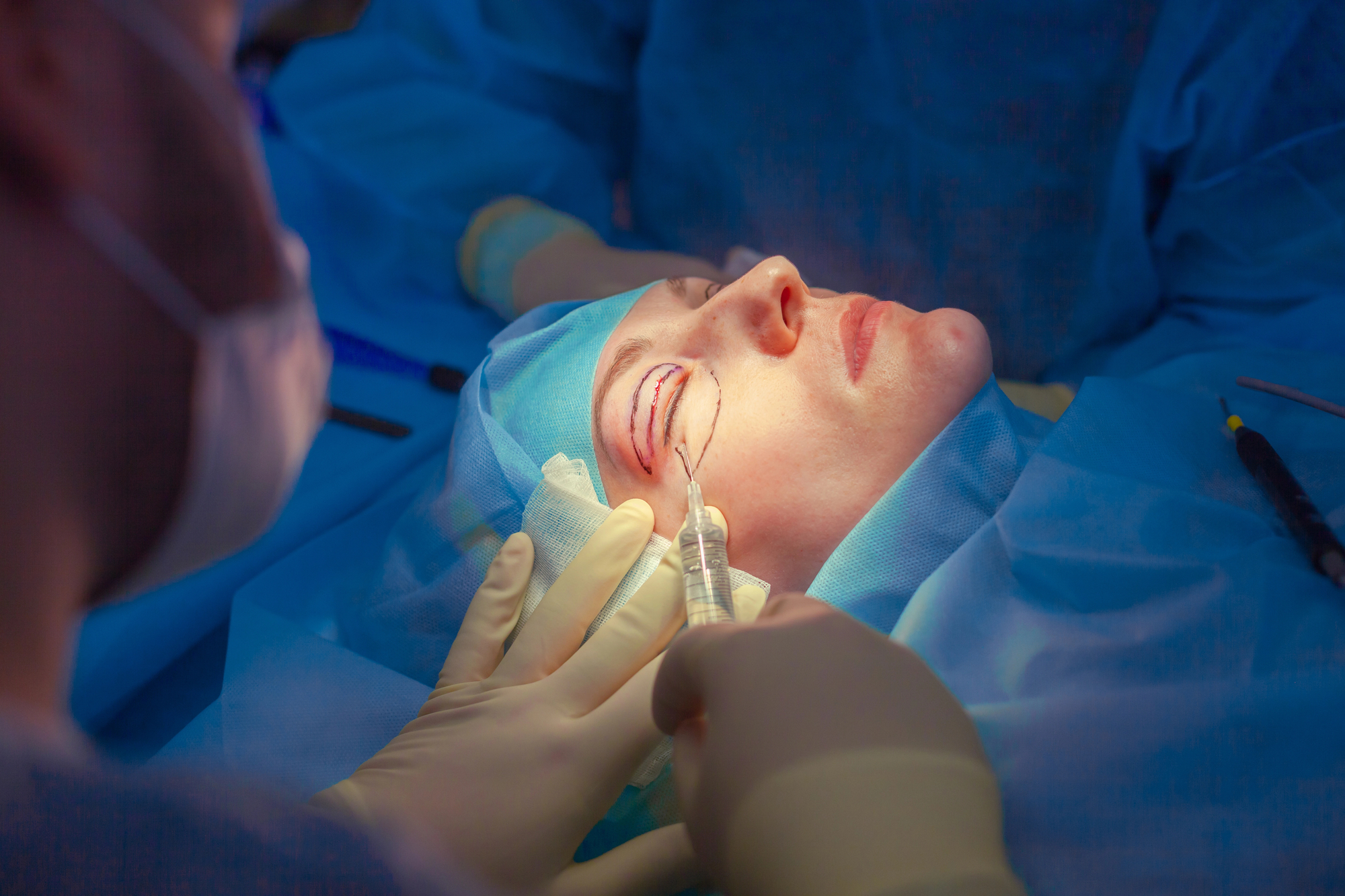Updated on February 5, 2024
What Happens During Canthoplasty?


Vision Center is funded by our readers. We may earn commissions if you purchase something via one of our links.
What is Canthoplasty?
Canthoplasty (cat-eye surgery) is reconstructive plastic surgery to create bigger, more attractive eyes. It involves reshaping the outer corner of the eye into an almond or cat’s eye shape. It’s also referred to as a cat-eye lift and almond-eye surgery.

Lateral cantoplasty surgery targets the lateral canthus. This is the outer corner of the eye, where the upper and lower eyelids connect to form a V-shape.
After the canthoplasty surgery, the canthus appears raised, and the eyes become brighter and more expressive. A fellowship-trained, board-certified oculoplastic surgeon must perform canthoplasty surgery.
How Much Does Canthoplasty Surgery Cost?
The average cost of cosmetic eyelid surgery is $4,120, according to The American Society of Plastic Surgeons (ASPS).2 However, costs range from just over $1,000 to more than $10,000.
What Affects How Much Canthoplasty Costs?
Various factors will influence how much you pay for canthoplasty surgery. These include:
- The location of your plastic surgeon’s office
- The surgeon’s level of expertise
- The complexity of your surgery and whether you’re combining it with other procedures, such as canthopexy or blepharoplasty
What Is Included in the Cost of Canthoplasty Surgery?
During your initial consultation, ask your surgeon for a comprehensive cost estimate that includes:
- The surgeon’s fee
- Facility fees
- Anesthesia
- Cost of presurgical care, such as medications or doctor’s appointments
- Cost of follow-up visits and aftercare
Does Insurance Cover the Cost of Canthoplasty?
Canthoplasty is an elective procedure, so insurance won’t cover it unless it’s required to treat a medical problem, such as chronic dry eyes.
Talk to your doctor and insurance provider about pricing before committing to the surgery. Some doctors offer financing options such as payment plans.
Types of Canthoplasty
Different canthoplasty techniques are used to correct various issues, including:
- Lateral canthoplasty. Repositions the outer corner of the eye to a more upward angle
- Medial canthoplasty. Repositions the inner corner of the eye to a downward angle
- Canthopexy. Corrects drooping eyelids by repositioning the canthi (plural of canthus)
Your surgeon will help you decide the best approach or combination of techniques to achieve your desired outcome.
Who is a Candidate for Canthoplasty Surgery?
Your initial consultation and examination will determine whether this eyelid surgery suits you.
The ideal candidate for canthoplasty has:
- Drooping eyelid (loose lower eyelid) due to aging, genetics, or lifestyle
- Good physical health
- No underlying medical conditions that may interfere with recovery
- Enough knowledge of the surgery and typical results
- Realistic expectations
- Refrained from certain medications that can cause excess bleeding
- The ability to follow post-op care guidelines
Canthoplasty Procedure: What to Expect
Cat-eye surgery is an outpatient procedure, meaning you’ll be discharged immediately after surgery. It uses local anesthesia and intravenous sedation to ease pain and help you relax throughout the procedure.3
If your doctor needs to do something more invasive, they will use general anesthesia to make you fall asleep.
The entire surgical procedure lasts about 2 hours or less.
Preparing for the Procedure
Preparation is important before any reconstructive surgery. You will be required to do the following before canthoplasty:
- Stop taking blood thinners (ibuprofen, apixaban, edoxaban, Heparin, etc.)
- Eat light the night before surgery
- Avoid food at least 6 hours before surgery
- Take your essential medication(s) as directed by your doctor and surgeon
- Avoid makeup, as it contains chemical irritants and attracts bacteria
- Rinse your face with water and soap on the day of surgery
- Do not apply face lotion or cream
- Make transportation arrangements, as your driving ability will be temporarily impaired after surgery
Canthoplasty Procedure Steps
Here’s what happens during canthoplasty surgery:
- After administering the local anesthesia, the surgeon will make an incision on the lateral canthal tendon.
- The surgeon will then detach the tendon and reposition, shorten, or tighten it to achieve the cat-eye shape.
- They will close the incision and dress it to prevent infection.
- An experienced surgeon can hide the scar by making an incision in the eye’s natural crease.
- They will prescribe antibiotic eye drops, ointments, steroid eye drops, and/or artificial tears to relieve pain and discomfort.
- They may also provide an eyeshield to protect eyes from dust, debris, and potential trauma, especially during sleep.
Aftercare & Recovery
Follow these post-op care instructions for successful recovery:
- Rest your eyes. Take off time from work or other commitments.
- Use an ice pack. This will help ease swelling.
- Maintain good eye hygiene to prevent infection. Clean the wound as directed by your surgeon.
- Avoid rubbing, squeezing, or touching your eyes. This may delay healing or cause other complications.
- Stop wearing contact lenses. Don’t wear contact lenses for about 2 weeks to avoid straining the healing tendons.
- Avoid certain medications. Non-steroidal anti-inflammatory drugs (NSAIDs), platelet inhibitors, and anticoagulants may increase bleeding.6
- Wear protective eye shields. Protect your eyes outdoors or sleeping to avoid accidental injury or exposure to dust, pollen, and other irritants.
- Attend post-operative visits. Your surgeon will want to see you again to monitor the healing wound.
- Wear sunscreen. Direct sunlight can slow healing and cause scar enlargement or skin discoloration.
- Take your medications. Your surgeon will prescribe pain medication, ointments, and/or eye drops. Take them as prescribed.
For most people, recovery takes 2 to 3 weeks. Full recovery may take several more weeks. The effects of the surgery (cat-eye-shaped eyes) will become apparent after a few months.
What are the Side Effects & Risks of Canthoplasty?
Canthoplasty risks and side effects include:
- Drowsiness, nausea, and vomiting due to anesthetics and sedatives used during surgery
- Swelling and bruising
- Blood clots
- Scarring
- Loose stitches
- Excessive tearing
- Dry eyes
- Mild to moderate pain
- Excessive bleeding
- Poor outer canthal alignment
- Conjunctival exposure
- Infections
In most cases, bruising and swelling will disappear within a week. Vision changes are likely in some people. These symptoms are only temporary.
Seek emergency medical care if you experience severe pain, shortness of breath, chest pains, bleeding, or infection after surgery.
Outlook & Success Rates
According to studies, the average success rate of canthoplasty is over 90%.9
Canthoplasty surgery can be safe, reliable, and successful if done correctly. Trained and knowledgeable ophthalmologists should perform the surgery only on suitable candidates.
Depending on the person’s condition, other surgeries, such as double eyelidplasty or epicanthoplasty, may be necessary to provide the best results.8
Summary
Canthoplasty is a reconstructive surgical procedure that improves the eye’s appearance. It involves cutting, repositioning, shortening, or removing excess skin from the outer part of the eyelids.
Once done, the eyes assume a cat’s eye shape, which is a commonly desired cosmetic feature. For best results, only an experienced eye surgeon should perform this procedure.
In this article
9 sources cited
Updated on February 5, 2024
Updated on February 5, 2024
About Our Contributors
Vincent Ayaga is a medical researcher and seasoned content writer with a bachelor's degree in Medical Microbiology. Specializing in disease investigation, prevention, and control, Vincent is dedicated to raising awareness about visual problems and the latest evidence-based solutions in ophthalmology. He strongly believes in the transformative power of ophthalmic education through research to inform and educate those seeking knowledge in eye health.
Dr. Melody Huang is an optometrist and freelance health writer with a passion for educating people about eye health. With her unique blend of clinical expertise and writing skills, Dr. Huang seeks to guide individuals towards healthier and happier lives. Her interests extend to Eastern medicine and integrative healthcare approaches. Outside of work, she enjoys exploring new skincare products, experimenting with food recipes, and spending time with her adopted cats.

